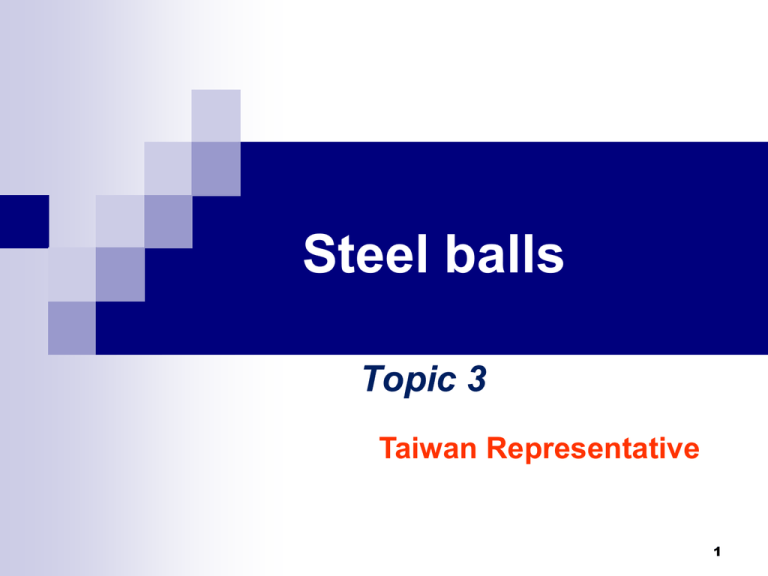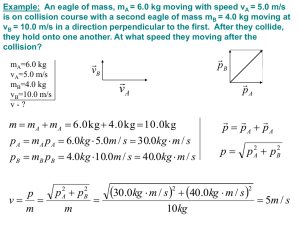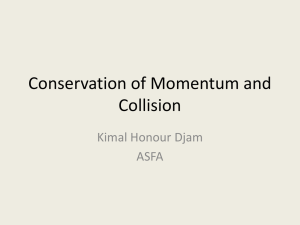ppt - IYPT Archive
advertisement

Steel balls Topic 3 Taiwan Representative 1 Outline Question Experimental set up: Vertical collision Materials: Paper, Plastic, and Metal sheets Experimental results: Hole size v.s materials, height… What we learned & discussion Conclusion 2 Question Colliding two large steel balls with a thin sheet of material (e.g. paper) in between may "burn" a hole in the sheet. Investigate this effect for various materials. 3 Experimental Setup: vertical collision H Sheet 1m 4 Materials o o 1. Paper (Burning point: 130 ~232 C) 2 mm 5 mm Reference:http://wiki.answers.com/Q/What _is_the_Burning_point_of_paper 5 Inflammable materials Paper Burned O2 Greatly heated A thin piece of material left on the ball 6 Materials 2. Plastic (Melting Point: 106~114℃) (Soften temperature: 80~98℃) 3 mm 4 mm 7 Non-flammable materials Plastic Cooled down Wrinkles Melted Compressed Into thin layer 8 Materials 3. Aluminum foil (Melting point: 660 C) 6 mm 5 mm 9 Non-flammable materials Aluminum foil Melted Compressed Concentric circles wrinkles 10 Materials 4.Copper foil (Melting Point: 1083.0 °C) 2mm 5 mm Reference:www.chemicalelements.com/elements/cu.html 11 Non-flammable materials Copper foil Melted ?? Depends on condition Compressed Concentric circles wrinkles 12 Plastic Paper = 7.6 cm H = 7.6 cm = 7.6 cm = 7.6 cm 13 Height v.s. Materials 14 Height v.s. Materials 15 Height v.s. Materials 16 Height v.s. Materials 17 Estimation of physical parameters during collision The highest temperature Tmax.= ? Duration ∆t = ? Collision area A=? Average pressure P = ? Conducted heat ∆Q = ? Adiabatic process? i.e. ∆W >> ∆Q 18 Tmax.= ? We can melt Al foil . Melting point of Al = 660 ℃. Cooled after melted 19 Duration ∆t = ? Our high speed video: 230 μs/frame 20 t=0 Dropping ball Edge of pillar Material Fixed ball 21 t=230μs Dropping ball Edge of pillar Material Fixed ball 22 t=230μs x 2 Dropping ball Edge of pillar Material Fixed ball 23 t=230μs x 3 Dropping ball Edge of pillar Material Fixed ball 24 Duration ∆t = ? 1. Our high speed video: 230 μs/frame ∆t < 230 μs our mball=287 g 2. From reference We can conclude : ∆t < 230 μs R. Hessel, A. C. Perinotto, R. A. M. Alfaro, and A. A. Freschia, Am. J. Phys. 74 3, 176 (2006). 25 Collision area A=? Estimate A from the melted Al foil . Diameter ~ 1.6 mm Diameter: 1.58± 0.08 mm Al foil 26 Average pressure P = ? F p 1 P A t A 2 po 2m 2gH p m 2gH po m=287 g, H=50 cm, g=9.8 m/s2, A< π(0.8mm) 2 , ∆t < 230 μs 0.287 2 9.8 0.5 1 4 9 Nt P 1.9 10 ( 2 ) 4 2 2.3 10 0.0008 3.14 m P 1.9 10 atm 27 Work ∆W=? Pressure P > 1.2 x 109 Nt/m2 Collision Area A=πr2 ~ 2x10-6 m2 Thickness of sheet ∆d= 10-4 m W P V P ( A d ) 3.9 101 ( J ) Conducted heat ∆Q=? Q A T t ∆T < 1000 ℃ A=πr2 ~ 2 x 10-6 m2 σ Air 0.026 Al 237 Cu 401 Fe 80.4 Steel 46 Water 0.61 Wood 0.11 Q 401 (2 106 ) 1000 2.3104 ~ 1.8 104 ( J ) 28 Heat produced W H m s T Using the lowest production of work, W 0.39( J ) Increase ofΔT , T 640 C T 25 640 665 C o o => Higher than melting point of Al: 660 29 Adiabatic process?? Work done during collision ∆W > 3.9 ×10-1 (J) Heat conducted during collision : ∆Q < 2.9 ×10-4 (J) Tlow Thigh ∆W >> ∆Q Adiabatic process 30 Conclusion Height: Diameter of holes increases as height increases Collision Area: Burning Melting 31 Colliding process P T P T 32 Burning O2 O2 33 Melting 34 Conclusion Height: Diameter of holes increases as height increases Collision Area: Melting Burning Adiabatic Process is the main reason holes are burned because: Δt is small Area is small Pressure is high T is high 35 Conclusion Height: Diameter of holes increases as height increases Collision Area: Melting Burning Adiabatic Process is the main reason holes are burned because: Δt is small Area is small Pressure is high T is high 36








